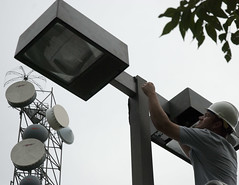
At The Atlantic's Cities Blog, Nate Berg points out that streetlights drain a huge amount of a community's budget, but thanks to new technologies,
cities like San Diego can slash their energy bills & carbon footprints:
Under the leadership of a program called CleanTECH San Diego, cities in the area have been able to streamline what would otherwise be a cumbersome process to make the switch from old bulbs to new. And with grant money from the American Recovery and Reinvestment Act of 2009, 13 cities in the region have kicked off projects to replace about 55,000 streetlights, which will save an estimated $3 million annually.
The largest among those cities is San Diego, which will be replacing about 90 percent of its streetlights, roughly 35,000. The city is replacing its old low-pressure sodium lights – a common streetlight – with induction bulbs that use about 40 percent less energy. 16,500 have already been converted, and officials expect the transition to be finished by next spring.
Before the conversion, the city had been paying about $4.7 million a year to light its streets. When all 35,000 lights are replaced, that cost will drop to about $2.8 million a year, according to Tom Blair, deputy environmental services director for the City of San Diego.
And it's not just energy costs that will go down. The old sodium bulbs typically had to be replaced every 3 or 4 years, while the new induction bulbs can last more than a decade. Blair says a set of induction bulbs were installed in downtown San Diego about 12 years ago and have yet to need replacement. "That’s a significant savings," Blair says.
"It was kind of a no-brainer," says Marty Turock, a program manager at CleanTECH San Diego. "Virtually every city, at least within San Diego County, recognized that doing the street lighting retrofits was one of the biggest impacts and one of the biggest payback energy efficiency projects they could take on."
Another leader -
Ann Arbor, MI, projected to save $100,000 a year by installing new LED streetlights with motion detectors (unlike older streetlight bulbs that need a few minutes to power up to full intensity, LEDs can fire up instantly).
 At The Atlantic's Cities Blog, Nate Berg points out that streetlights drain a huge amount of a community's budget, but thanks to new technologies, cities like San Diego can slash their energy bills & carbon footprints:
At The Atlantic's Cities Blog, Nate Berg points out that streetlights drain a huge amount of a community's budget, but thanks to new technologies, cities like San Diego can slash their energy bills & carbon footprints:
No comments:
Post a Comment